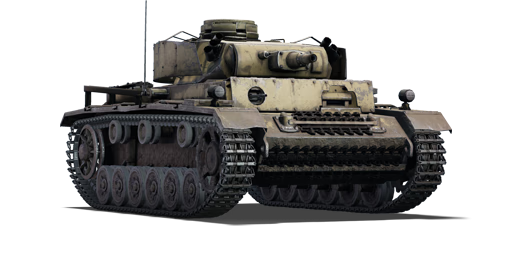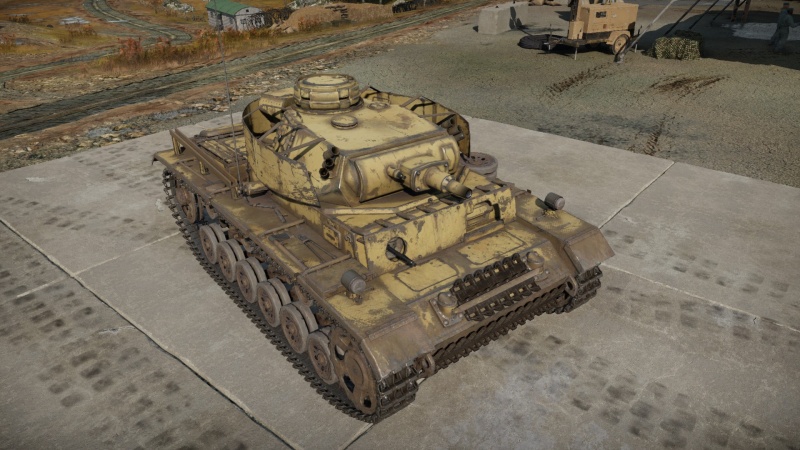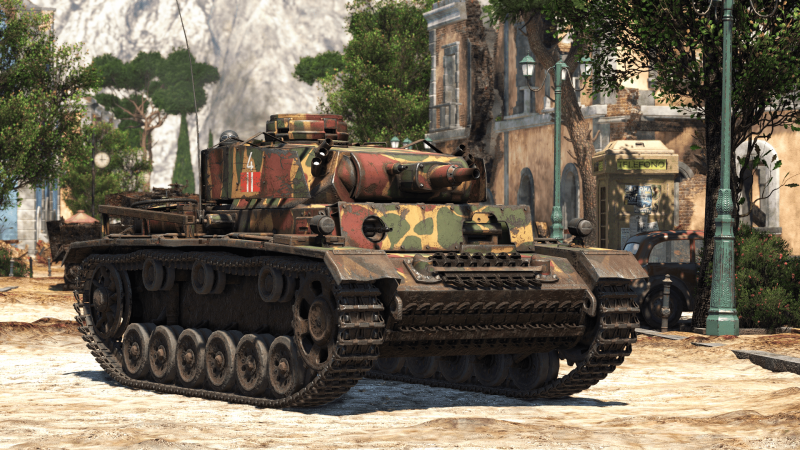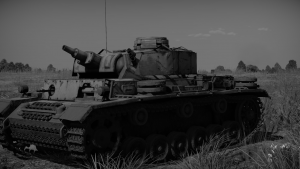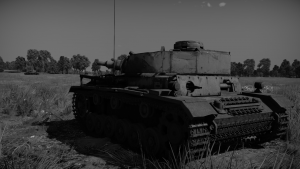Difference between revisions of "Pz.III N (Italy)"
(→History: added media) (Tag: Visual edit) |
(→Description) |
||
| (16 intermediate revisions by 6 users not shown) | |||
| Line 2: | Line 2: | ||
| about = medium tank '''{{PAGENAME}}''' | | about = medium tank '''{{PAGENAME}}''' | ||
| usage = other versions | | usage = other versions | ||
| − | | link = | + | | link = Panzer III (Family) |
}} | }} | ||
{{Specs-Card | {{Specs-Card | ||
|code=it_pzkpfw_III_ausf_N | |code=it_pzkpfw_III_ausf_N | ||
| − | |images={{Specs-Card-Image|GarageImage_{{PAGENAME}}.jpg}} | + | |images={{Specs-Card-Image|GarageImage_{{PAGENAME}}.jpg|ArtImage_{{PAGENAME}}.png}} |
}} | }} | ||
== Description == | == Description == | ||
<!-- ''In the description, the first part should be about the history of the creation and combat usage of the vehicle, as well as its key features. In the second part, tell the reader about the ground vehicle in the game. Insert a screenshot of the vehicle, so that if the novice player does not remember the vehicle by name, he will immediately understand what kind of vehicle the article is talking about.'' --> | <!-- ''In the description, the first part should be about the history of the creation and combat usage of the vehicle, as well as its key features. In the second part, tell the reader about the ground vehicle in the game. Insert a screenshot of the vehicle, so that if the novice player does not remember the vehicle by name, he will immediately understand what kind of vehicle the article is talking about.'' --> | ||
| − | The | + | During the advance of the Allies on Italian territory in 1943, Germany began to send different types of vehicles to Italy (RSI) to increase their effectiveness and in turn improve the defence of the territory, including aircraft, light vehicles, transport vehicles, cannons, and eventually tanks. In particular, Pz.IV G, Pz.III N, and eventually StuG III G were sent, and these would be used in the 1st Armoured Division Black Shirts "M" formed in the same year and was divided into three companies, the second of which had 12 Pz.III N, with a particular difference, the removal of the side skirts. The Italian Pz.III N would not see combat as the division was still in training, and were eventually recovered by the Germans only to be captured by the Allies during the advance towards Germany. |
| − | + | Introduced in [[Update "Ixwa Strike"]], the Italian Pz.III N is practically the same as the German one but with the side skirts removed, so you will be a little less covered on the sides. The cannon penetrates up to 100 mm maximum with the HEAT, so it is sensible to try to aim for weak points of the enemy tanks. It is also devoid of the machine gun on the commander's cupola which is present in the German Pz.III N. | |
== General info == | == General info == | ||
| Line 29: | Line 29: | ||
! Armour !! Front (Slope angle) !! Sides !! Rear !! Roof | ! Armour !! Front (Slope angle) !! Sides !! Rear !! Roof | ||
|- | |- | ||
| − | | Hull || 20 + 50 | + | | Hull || 20 + 50 mm ''Upper plate'' <br> 50 mm (53°) ''Upper glacis'' <br> 53 mm (22°) ''Lower plate'' <br> 30 mm (74°) ''Lower glacis'' || 30mm || 32 mm (44°) ''Upper glacis'' <br> 53 mm (16°) ''Upper plate'' <br> 53 mm (10°) ''Lower plate'' <br> 30 mm (65°) ''Lower glacis'' || 26 mm (6°) ''Front'' <br> 18 mm ''Centre'' <br> 15-17 mm (2-11°) ''Rear'' |
|- | |- | ||
| − | | Turret || 50 mm (cylindrical) | + | | Turret || 50 mm (cylindrical) ''Turret front'' <br> 50 mm ''Gun mantlet'' || 30 mm (17-25°) || 30 mm (conical) || 10 mm (7°) |
|- | |- | ||
| Cupola || 50 + 30 mm (cylindrical) || 50 + 30 mm (cylindrical) || 50 + 30 mm (cylindrical) || 10 mm | | Cupola || 50 + 30 mm (cylindrical) || 50 + 30 mm (cylindrical) || 50 + 30 mm (cylindrical) || 10 mm | ||
| Line 76: | Line 76: | ||
==== Ammunition ==== | ==== Ammunition ==== | ||
| − | { | + | {{:KwK37 (75 mm)/Ammunition|K.Gr.rot Pz., Hl.Gr 38B, Sprgr. 34, Hl.Gr 38C, K.Gr.Rot Nb.}} |
| − | |||
| − | |||
| − | |||
| − | |||
| − | |||
| − | |||
| − | |||
| − | |||
| − | |||
| − | |||
| − | |||
| − | |||
| − | |||
| − | |||
| − | |||
| − | |||
| − | |||
| − | |||
| − | |||
| − | |||
| − | |||
| − | |||
| − | |||
| − | |||
| − | |||
| − | |||
| − | |||
| − | |||
| − | |||
| − | |||
| − | |||
| − | | K.Gr.rot Pz. | ||
| − | |||
| − | |||
| − | |||
| − | |||
| − | |||
| − | |||
| − | |||
| − | |||
| − | |||
| − | |||
| − | |||
| − | |||
| − | |||
| − | |||
| − | |||
| − | |||
| − | |||
| − | |||
| − | |||
| − | |||
| − | |||
| − | |||
==== [[Ammo racks]] ==== | ==== [[Ammo racks]] ==== | ||
| Line 169: | Line 115: | ||
<!-- ''Describe the tactics of playing in the vehicle, the features of using vehicles in the team and advice on tactics. Refrain from creating a "guide" - do not impose a single point of view but instead give the reader food for thought. Describe the most dangerous enemies and give recommendations on fighting them. If necessary, note the specifics of the game in different modes (AB, RB, SB).'' --> | <!-- ''Describe the tactics of playing in the vehicle, the features of using vehicles in the team and advice on tactics. Refrain from creating a "guide" - do not impose a single point of view but instead give the reader food for thought. Describe the most dangerous enemies and give recommendations on fighting them. If necessary, note the specifics of the game in different modes (AB, RB, SB).'' --> | ||
| − | One of the most effective ways to play the Pz.III N is as either a brawler or support tank. As a brawler you'll essentially be one of the few people on your team leading the charge against the enemy team. Unlike other Italian tanks at a similar battle rating, you actually have somewhat of a reliable | + | One of the most effective ways to play the Pz.III N is as either a brawler or support tank. As a brawler you'll essentially be one of the few people on your team leading the charge against the enemy team. Unlike other Italian tanks at a similar battle rating, you actually have somewhat of a reliable armor that can come in very useful when charging the enemy, especially by surprise due to the enemy being caught off-guard and likely misplacing their initial shot. Although its speed is not really the best, with powertrain and engine upgrades that improve the mobility of the tank, you should still be able to keep up fairly well on a flat surface. Protection-wise, make sure you angle your tank if you are not charging the enemy, this will increase your chances of survival. The main asset when playing in the brawler role is your 75 mm KwK37 cannon. This cannon can easily make short work with the majority of the enemies you'll be facing at your BR. Sadly, its stock rounds are not the best so new players might struggle to penetrate from time to time. Once you have unlocked the Hl.Gr 38C HEAT round, you'll be easily taking out enemies frontally. This again will aid you heavily when playing as a brawler. As a support tank, you'll be providing essential support for your team which will greatly increase your chances to get a victory. The support role can be played in many ways, for example some players prefer to get to a good vantage point at the start of the map, usually a place that overlooks key points of a map, such as a capture zones or enemy spawn points. Others prefer to stay behind the main line of tanks leading the charge, and coming in either to assist teammates in eliminating enemy vehicles or by flanking enemy positions to get the edge over them whenever you manage to spot them. It is also recommended that you bring either a back-up vehicle or a strike aircraft in the case you end up perishing during the fight. One of the main weaknesses of this tank is when you're detected or ranged by a tank or tank destroyer (assuming they have an angle that negates your cover's protection), your armor will not protect you from powerful guns. Your sides are the most vulnerable part of the vehicle, so always keep it in mind wherever you are going, as your average speed will make you an easy target for enemy snipers. Also, keep in mind which game mode you are playing, as in Arcade Battles enemies can easily find out where you are located due to the name tag showing up above you, and are able to quickly find out where your weak spots are. |
=== Pros and cons === | === Pros and cons === | ||
| Line 177: | Line 123: | ||
* Spaced armour covering the turret of the tank | * Spaced armour covering the turret of the tank | ||
| + | * Small silhouette | ||
| + | * Good mobility | ||
* Fast-firing main gun | * Fast-firing main gun | ||
'''Cons:''' | '''Cons:''' | ||
| + | * Lacks hull side skirts seen on the German Pz.III N | ||
* May have trouble penetrating heavily armoured tanks | * May have trouble penetrating heavily armoured tanks | ||
* Hard to aim at long ranges | * Hard to aim at long ranges | ||
| − | * | + | * Poor stock rounds |
== History == | == History == | ||
| − | <!-- ''Describe the history of the creation and combat usage of the vehicle in more detail than in the introduction. If the historical reference turns out to be too long, take it to a separate article, taking a link to the article about the vehicle and adding a block "/History" (example: <nowiki>https://wiki.warthunder.com/(Vehicle-name)/History</nowiki>) and add a link to it here using the <code>main</code> template. Be sure to reference text and sources by using <code><nowiki><ref></ref></nowiki></code>, as well as adding them at the end of the article with <code><nowiki><references /></nowiki></code>. This section may also include the vehicle's dev blog entry (if applicable) and the in-game encyclopedia description (under <code><nowiki>=== In-game description ===</nowiki></code>, also if applicable).'' -->[[File:Pz.III N (Div.M.) (2) .png|thumb|Pz.III N (Div.M.) during training]] | + | <!-- ''Describe the history of the creation and combat usage of the vehicle in more detail than in the introduction. If the historical reference turns out to be too long, take it to a separate article, taking a link to the article about the vehicle and adding a block "/History" (example: <nowiki>https://wiki.warthunder.com/(Vehicle-name)/History</nowiki>) and add a link to it here using the <code>main</code> template. Be sure to reference text and sources by using <code><nowiki><ref></ref></nowiki></code>, as well as adding them at the end of the article with <code><nowiki><references /></nowiki></code>. This section may also include the vehicle's dev blog entry (if applicable) and the in-game encyclopedia description (under <code><nowiki>=== In-game description ===</nowiki></code>, also if applicable).'' --> |
| + | [[File:Pz.III N (Div.M.) (2) .png|thumb|Pz.III N (Div.M.) during training]] | ||
The history of Pz.Kpfw. III Ausf. N began in Germany of 1942, this variant was mainly an assault tank based on the Ausf. L and Ausf. M chassis, which was re-used to produce this tank. This variant was produced to meet the need for a stronger tank, one that could more effectively handle the Soviet T-34 and KV-1. There was also a desperate need for a special infantry support tank which would be used during advances alongside soldiers on the ground. It had a somewhat complicated development cycle, for example the widely used 75 mm long-barreled gun could not be installed in the turret due to the limited turret internal size. The German designers instead decided to use the short-barreled 7.5 cm KwK37 L/24 gun, which would be paired alongside with special hollow-charge shells. This explosive projectile packed more punch than the 5 cm KwK39 L/60 gun, so at the time it was favoured and underwent a series of trials, which were an overall success. Some design features of the tank had to be modified however, for example, the gun's mantlet was redesigned to accommodate the changes done. Other aspects of the vehicle also became better: the gun's recoil mechanisms were improved, the single-hinged hatch for the command turret was replaced with a two-hinged hatch, the thickness of the commander's cupola was increased to 100 mm. This variant's overall operational weight was around 23 tons. Most of the tanks received 5 mm side skirts (Schürzen) to protect the tank's hull and turret., however Italian variants, in Italian fashion, removed said side skirts. Production of the Pz.Kpfw. III Ausf. N tanks began in June 1942 and lasted until August 1943. A total of 700 of these tanks were built. 3 were built from Pz.Kpfw. III Ausf. J tanks, 447 from Pz.Kpfw. III Ausf. L tanks, 213 from Pz.Kpfw. III Ausf. M tanks, and 37 from other variants after they had returned from the front. | The history of Pz.Kpfw. III Ausf. N began in Germany of 1942, this variant was mainly an assault tank based on the Ausf. L and Ausf. M chassis, which was re-used to produce this tank. This variant was produced to meet the need for a stronger tank, one that could more effectively handle the Soviet T-34 and KV-1. There was also a desperate need for a special infantry support tank which would be used during advances alongside soldiers on the ground. It had a somewhat complicated development cycle, for example the widely used 75 mm long-barreled gun could not be installed in the turret due to the limited turret internal size. The German designers instead decided to use the short-barreled 7.5 cm KwK37 L/24 gun, which would be paired alongside with special hollow-charge shells. This explosive projectile packed more punch than the 5 cm KwK39 L/60 gun, so at the time it was favoured and underwent a series of trials, which were an overall success. Some design features of the tank had to be modified however, for example, the gun's mantlet was redesigned to accommodate the changes done. Other aspects of the vehicle also became better: the gun's recoil mechanisms were improved, the single-hinged hatch for the command turret was replaced with a two-hinged hatch, the thickness of the commander's cupola was increased to 100 mm. This variant's overall operational weight was around 23 tons. Most of the tanks received 5 mm side skirts (Schürzen) to protect the tank's hull and turret., however Italian variants, in Italian fashion, removed said side skirts. Production of the Pz.Kpfw. III Ausf. N tanks began in June 1942 and lasted until August 1943. A total of 700 of these tanks were built. 3 were built from Pz.Kpfw. III Ausf. J tanks, 447 from Pz.Kpfw. III Ausf. L tanks, 213 from Pz.Kpfw. III Ausf. M tanks, and 37 from other variants after they had returned from the front. | ||
[[File:Pz.III N (Div.M.) (1).png|thumb|Pz.III N (Div.M.) during training]] | [[File:Pz.III N (Div.M.) (1).png|thumb|Pz.III N (Div.M.) during training]] | ||
| Line 197: | Line 147: | ||
* [https://live.warthunder.com/feed/camouflages/?vehicle=it_pzkpfw_III_ausf_N Skins and camouflages for the {{PAGENAME}} from live.warthunder.com.] | * [https://live.warthunder.com/feed/camouflages/?vehicle=it_pzkpfw_III_ausf_N Skins and camouflages for the {{PAGENAME}} from live.warthunder.com.] | ||
| + | |||
| + | ;Videos | ||
| + | {{Youtube-gallery|pKSAaUxvPE8|'''IXWA Strike - Panzer III N for Italy''' - ''8Bit Dane''}} | ||
== See also == | == See also == | ||
Latest revision as of 21:25, 23 April 2023
| This page is about the medium tank Pz.III N (Italy). For other versions, see Panzer III (Family). |
Contents
Description
During the advance of the Allies on Italian territory in 1943, Germany began to send different types of vehicles to Italy (RSI) to increase their effectiveness and in turn improve the defence of the territory, including aircraft, light vehicles, transport vehicles, cannons, and eventually tanks. In particular, Pz.IV G, Pz.III N, and eventually StuG III G were sent, and these would be used in the 1st Armoured Division Black Shirts "M" formed in the same year and was divided into three companies, the second of which had 12 Pz.III N, with a particular difference, the removal of the side skirts. The Italian Pz.III N would not see combat as the division was still in training, and were eventually recovered by the Germans only to be captured by the Allies during the advance towards Germany.
Introduced in Update "Ixwa Strike", the Italian Pz.III N is practically the same as the German one but with the side skirts removed, so you will be a little less covered on the sides. The cannon penetrates up to 100 mm maximum with the HEAT, so it is sensible to try to aim for weak points of the enemy tanks. It is also devoid of the machine gun on the commander's cupola which is present in the German Pz.III N.
General info
Survivability and armour
Armour type:
- Rolled homogeneous armour (hull, turret, cupola roof)
- Cast homogeneous armour (cupola, gun mantlet)
| Armour | Front (Slope angle) | Sides | Rear | Roof |
|---|---|---|---|---|
| Hull | 20 + 50 mm Upper plate 50 mm (53°) Upper glacis 53 mm (22°) Lower plate 30 mm (74°) Lower glacis |
30mm | 32 mm (44°) Upper glacis 53 mm (16°) Upper plate 53 mm (10°) Lower plate 30 mm (65°) Lower glacis |
26 mm (6°) Front 18 mm Centre 15-17 mm (2-11°) Rear |
| Turret | 50 mm (cylindrical) Turret front 50 mm Gun mantlet |
30 mm (17-25°) | 30 mm (conical) | 10 mm (7°) |
| Cupola | 50 + 30 mm (cylindrical) | 50 + 30 mm (cylindrical) | 50 + 30 mm (cylindrical) | 10 mm |
Notes:
- Suspension wheels and torsion bars are 15 mm thick while tracks are 20 mm thick.
- Track links used as add-on armour are 20 mm thick.
- The turret sides and rear are protected by 8 mm skirts which provide protection against HEAT and HE shells
Mobility
| Game Mode | Max Speed (km/h) | Weight (tons) | Engine power (horsepower) | Power-to-weight ratio (hp/ton) | |||
|---|---|---|---|---|---|---|---|
| Forward | Reverse | Stock | Upgraded | Stock | Upgraded | ||
| Arcade | 60 | 12 | 23 | 465 | 572 | 20.22 | 24.87 |
| Realistic | 54 | 10 | 265 | 300 | 11.52 | 13.04 | |
Modifications and economy
Armaments
Main armament
| 75 mm KwK37 | Turret rotation speed (°/s) | Reloading rate (seconds) | |||||||||||
|---|---|---|---|---|---|---|---|---|---|---|---|---|---|
| Mode | Capacity | Vertical | Horizontal | Stabilizer | Stock | Upgraded | Full | Expert | Aced | Stock | Full | Expert | Aced |
| Arcade | 64 | -10°/+20° | ±180° | N/A | 13.3 | 18.4 | 22.4 | 24.8 | 26.4 | 4.29 | 3.80 | 3.50 | 3.30 |
| Realistic | 8.3 | 9.8 | 11.9 | 13.2 | 14.0 | ||||||||
Ammunition
| Penetration statistics | |||||||
|---|---|---|---|---|---|---|---|
| Ammunition | Type of warhead |
Penetration @ 0° Angle of Attack (mm) | |||||
| 10 m | 100 m | 500 m | 1,000 m | 1,500 m | 2,000 m | ||
| K.Gr.rot Pz. | APCBC | 52 | 51 | 45 | 39 | 34 | 30 |
| Hl.Gr 38B | HEAT | 80 | 80 | 80 | 80 | 80 | 80 |
| Sprgr. 34 | HE | 10 | 10 | 10 | 10 | 10 | 10 |
| Hl.Gr 38C | HEAT | 115 | 115 | 115 | 115 | 115 | 115 |
| Shell details | ||||||||||||
|---|---|---|---|---|---|---|---|---|---|---|---|---|
| Ammunition | Type of warhead |
Velocity (m/s) |
Projectile mass (kg) |
Fuse delay (m) |
Fuse sensitivity (mm) |
Explosive mass (TNT equivalent) (g) |
Ricochet | |||||
| 0% | 50% | 100% | ||||||||||
| K.Gr.rot Pz. | APCBC | 385 | 6.8 | 1.2 | 14 | 102.4 | 48° | 63° | 71° | |||
| Hl.Gr 38B | HEAT | 450 | 4.57 | 0.05 | 0.1 | 872.1 | 62° | 69° | 73° | |||
| Sprgr. 34 | HE | 420 | 5.74 | 0.2 | 0.1 | 686 | 79° | 80° | 81° | |||
| Hl.Gr 38C | HEAT | 450 | 4.8 | 0.05 | 0.1 | 875.5 | 62° | 69° | 73° | |||
| Smoke shell characteristics | ||||||
|---|---|---|---|---|---|---|
| Ammunition | Velocity (m/s) |
Projectile mass (kg) |
Screen radius (m) |
Screen deploy time (s) |
Screen hold time (s) |
Explosive mass (TNT equivalent) (g) |
| K.Gr.Rot Nb. | 423 | 6.2 | 9 | 5 | 20 | 50 |
Ammo racks
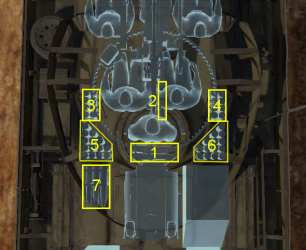
| Full ammo |
1st rack empty |
2nd rack empty |
3rd rack empty |
4th rack empty |
5th rack empty |
6th rack empty |
7th rack empty |
Visual discrepancy |
|---|---|---|---|---|---|---|---|---|
| 64 | 57 (+7) | 54 (+10) | 46 (+18) | 38 (+26) | 24 (+40) | 10 (+54) | 1 (+63) | No |
Machine guns
| 7.92 mm MG34 | ||||
|---|---|---|---|---|
| Mount | Capacity (Belt) | Fire rate | Vertical | Horizontal |
| Coaxial | 3,450 (150) | 900 | N/A | N/A |
Usage in battles
One of the most effective ways to play the Pz.III N is as either a brawler or support tank. As a brawler you'll essentially be one of the few people on your team leading the charge against the enemy team. Unlike other Italian tanks at a similar battle rating, you actually have somewhat of a reliable armor that can come in very useful when charging the enemy, especially by surprise due to the enemy being caught off-guard and likely misplacing their initial shot. Although its speed is not really the best, with powertrain and engine upgrades that improve the mobility of the tank, you should still be able to keep up fairly well on a flat surface. Protection-wise, make sure you angle your tank if you are not charging the enemy, this will increase your chances of survival. The main asset when playing in the brawler role is your 75 mm KwK37 cannon. This cannon can easily make short work with the majority of the enemies you'll be facing at your BR. Sadly, its stock rounds are not the best so new players might struggle to penetrate from time to time. Once you have unlocked the Hl.Gr 38C HEAT round, you'll be easily taking out enemies frontally. This again will aid you heavily when playing as a brawler. As a support tank, you'll be providing essential support for your team which will greatly increase your chances to get a victory. The support role can be played in many ways, for example some players prefer to get to a good vantage point at the start of the map, usually a place that overlooks key points of a map, such as a capture zones or enemy spawn points. Others prefer to stay behind the main line of tanks leading the charge, and coming in either to assist teammates in eliminating enemy vehicles or by flanking enemy positions to get the edge over them whenever you manage to spot them. It is also recommended that you bring either a back-up vehicle or a strike aircraft in the case you end up perishing during the fight. One of the main weaknesses of this tank is when you're detected or ranged by a tank or tank destroyer (assuming they have an angle that negates your cover's protection), your armor will not protect you from powerful guns. Your sides are the most vulnerable part of the vehicle, so always keep it in mind wherever you are going, as your average speed will make you an easy target for enemy snipers. Also, keep in mind which game mode you are playing, as in Arcade Battles enemies can easily find out where you are located due to the name tag showing up above you, and are able to quickly find out where your weak spots are.
Pros and cons
Pros:
- Spaced armour covering the turret of the tank
- Small silhouette
- Good mobility
- Fast-firing main gun
Cons:
- Lacks hull side skirts seen on the German Pz.III N
- May have trouble penetrating heavily armoured tanks
- Hard to aim at long ranges
- Poor stock rounds
History
The history of Pz.Kpfw. III Ausf. N began in Germany of 1942, this variant was mainly an assault tank based on the Ausf. L and Ausf. M chassis, which was re-used to produce this tank. This variant was produced to meet the need for a stronger tank, one that could more effectively handle the Soviet T-34 and KV-1. There was also a desperate need for a special infantry support tank which would be used during advances alongside soldiers on the ground. It had a somewhat complicated development cycle, for example the widely used 75 mm long-barreled gun could not be installed in the turret due to the limited turret internal size. The German designers instead decided to use the short-barreled 7.5 cm KwK37 L/24 gun, which would be paired alongside with special hollow-charge shells. This explosive projectile packed more punch than the 5 cm KwK39 L/60 gun, so at the time it was favoured and underwent a series of trials, which were an overall success. Some design features of the tank had to be modified however, for example, the gun's mantlet was redesigned to accommodate the changes done. Other aspects of the vehicle also became better: the gun's recoil mechanisms were improved, the single-hinged hatch for the command turret was replaced with a two-hinged hatch, the thickness of the commander's cupola was increased to 100 mm. This variant's overall operational weight was around 23 tons. Most of the tanks received 5 mm side skirts (Schürzen) to protect the tank's hull and turret., however Italian variants, in Italian fashion, removed said side skirts. Production of the Pz.Kpfw. III Ausf. N tanks began in June 1942 and lasted until August 1943. A total of 700 of these tanks were built. 3 were built from Pz.Kpfw. III Ausf. J tanks, 447 from Pz.Kpfw. III Ausf. L tanks, 213 from Pz.Kpfw. III Ausf. M tanks, and 37 from other variants after they had returned from the front.
Concerning the Italian operational of this tank, Germany during the late stages of the second world war had supplied 12 units of Panzer IV G to Italy, which were placed in the Division "M" and, after the 25th of July, they were transferred to the 136th Armored Division "Centauro II". The 1st Armored Division Black Shirts "M" (for "Mussolini") was established starting from May of 1943, mainly starting from the very few survivors of the previous MVSN Battalions M who had been repatriated from the Russian front, this had to be done if there was hope for any new division being formed. The division was organised in 3 companies, the second company used 12 Panzer Kpfw III Ausf. N tanks, they were slightly modified however: they featured the 7.5 cm L/24 cannon, but something unique not previously installed on the same model, would be the smoke grenade launcher on the turret. As previously mentioned, they also removed the side skirts of the vehicle, and they were painted in a light tan color with the Divisione "M" logo painted onto the turret. They didn't see any action during the war, most of them were still undergoing training at the time. Most of the tanks ended up in Allied hands after the war. In conclusion, this tank variant earned a good reputation with the troops that had used it and by the beginning of the battle at the Kursk Bulge, the Wehrmacht and Waffen-SS owned 155 vehicles of this type. Some of the tanks were also transferred to Romania, Slovakia, and Croatia. Tanks of this variant were used until the end of the war and were transferred to Allied forces after Germany's surrender.
Media
- Skins
- Videos
See also
Links to the articles on the War Thunder Wiki that you think will be useful for the reader, for example:
- reference to the series of the vehicles;
- links to approximate analogues of other nations and research trees.
External links
Paste links to sources and external resources, such as:
- topic on the official game forum;
- other literature.
| Italy medium tanks | |
|---|---|
| Italy | |
| M13/40 | M13/40 (I) · M13/40 (II) · M13/40 (III) |
| M14/41 | M14/41 · M14/41 (47/40) |
| M15/42 | M15/42 |
| M16/43 | Celere Sahariano |
| P26/40 | P40 · P40 "G.C. Leoncello" |
| OF-40 | OF-40 · OF-40 Mk.2A · OF-40 (MTCA) |
| Ariete | Ariete (P) · Ariete · Ariete PSO · Ariete AMV |
| Germany | ▄Pz.III N · ▄Pz.IV G · ▄Leopard 1A5 |
| Allied powers | ▄Sherman I Composito · Sherman Ic · ▄Sherman Vc · ▄Sherman V · M26 "D.C.Ariete" · M26A1 · M47 (105/55) · M60A1 "D.C.Ariete" |
| Hungary | |
| Turán | Turan I · Turan II · Turan III |
| Germany | ◔Leopard 2A4 · Leopard 2A7HU |
| USSR | ◔T-72M1 |


